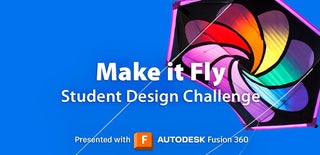Introduction: Sculpting Flight: 3D Printing a Retractable Squirrel Glider.
The one thing that is cooler than flying birds is flying squirrels! This Instructable is a quick guide on how to 3D print a flying squirrel that has retractable arms and actually glides!
My name is Brennley Jackson and I am a junior at Weber Innovation High School. A couple of years ago, I was introduced to 3D printing and it has me hooked! I love to print functional models, especially if I modeled it myself. When I came across this contest, I decided that I'd give it a try and see if my 3D modeling skills could provide a future career.
Supplies
The supplies needed for this glider:
- 3D printer and filament
- Plastic table cover (Dollar tree has a lot of colors)
- Small rubber bands (Rainbow loom bands work great)
- Hot glue / tape
Step 1: 3D Print Parts
The first step is to load in the filament color of your choice and 3D print the file below.
This file has all of the parts already arranged to fit on a 220 x 220 bed.
These are the settings needed:
- Enable supports
- Infill < 10% (needs to be light)
- Layer height does not matter (smaller layers will provide a better result)
- Rafts or Brims are only necessary if you have bad bed adhesion
Step 2: Preparing Parts
Once all of the parts are printed, you can clean any imperfections. The cutters that come with your printer or a rotary tool such as a Dremel will work great. It is also a good idea to drill out the four holes (that are covered with tape in the image) with a 5/64ths drill bit as well as the hole in each limb for the hinge to work smoothly.
Before you start the assembly process, placing a little piece of tape on the four holes (like in the picture) on both main bodies will help later on.
Step 3: Assembly Part 1
To begin the assembly, cut four sections of 1.75mm filament, just shy of 1cm each. These will become the hinge for each limb. You can then place these pieces of filament into the holes with the tape on the bottom side.
Step 4: Assembly Part 2
Next, the tail can be added to back of the main body. You can now place the limbs into place by sliding them onto the pieces of filament as show in the image above. Then, add the elastic bands onto the little pegs of each limb. This is followed by the little clips that need to be positioned correctly like in the third image. The head can be slid on the front of the body, however, it can be hot glued if the peg breaks off. The top can now be placed onto the body by aligning all of the pieces.
Step 5: Attach Wings
Open the table cover to one thin layer. Trace around the limbs, for a rectangular wing Tape edges of wings to the backside of squirrel's limbs. Repeat for the other side.
Step 6: You Are Finished!
Pinch the tabs on the bottom to retract the wings. Then, throw the squirrel with the nose slightly up and watch the wings come out. Have fun flying!

Runner Up in the
Make it Fly Student Design Challenge











